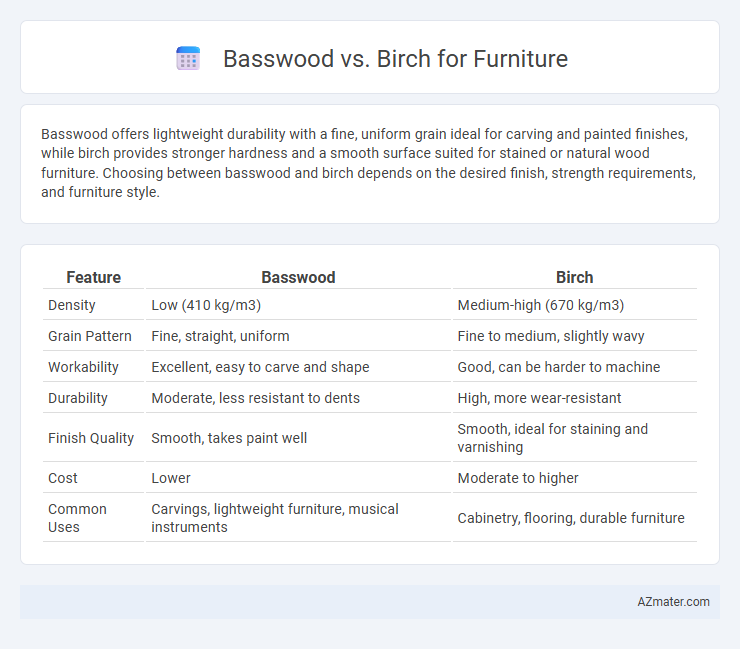Basswood offers lightweight durability with a fine, uniform grain ideal for carving and painted finishes, while birch provides stronger hardness and a smooth surface suited for stained or natural wood furniture. Choosing between basswood and birch depends on the desired finish, strength requirements, and furniture style.
Table of Comparison
| Feature | Basswood | Birch |
|---|---|---|
| Density | Low (410 kg/m3) | Medium-high (670 kg/m3) |
| Grain Pattern | Fine, straight, uniform | Fine to medium, slightly wavy |
| Workability | Excellent, easy to carve and shape | Good, can be harder to machine |
| Durability | Moderate, less resistant to dents | High, more wear-resistant |
| Finish Quality | Smooth, takes paint well | Smooth, ideal for staining and varnishing |
| Cost | Lower | Moderate to higher |
| Common Uses | Carvings, lightweight furniture, musical instruments | Cabinetry, flooring, durable furniture |
Introduction to Basswood and Birch
Basswood is a lightweight, soft hardwood known for its fine, even grain and excellent workability, making it a favorite among woodworkers for intricate furniture detailing. Birch, a denser and harder wood, features a smooth texture with a pale yellow to light brown hue, valued for its durability and resistance to wear in furniture construction. Both woods offer distinct aesthetic and functional qualities, influencing their use in various furniture styles and applications.
Wood Characteristics: Basswood vs Birch
Basswood features a light, soft texture with a fine, even grain, making it easy to carve and ideal for intricate detailing in furniture. Birch is harder and denser, with a smooth, closed grain that offers greater durability and resistance to dents, suitable for heavy-use furniture pieces. Both woods provide a pale color palette, but birch has a slightly warmer tone, while basswood lends a more uniform and lighter finish.
Aesthetic Differences
Basswood exhibits a light, creamy color with a subtle, uniform grain pattern that creates a smooth, understated aesthetic ideal for painted or minimalist furniture. Birch features a slightly warmer tone and a more pronounced, wavy grain that adds visual texture and richness, making it popular for natural or clear finishes. The choice between basswood and birch for furniture greatly impacts the piece's overall look, with basswood offering simplicity and birch providing dynamic elegance.
Durability and Strength Comparison
Basswood offers moderate durability with a fine, uniform texture, making it ideal for lightweight furniture and detailed carvings. Birch provides greater strength and hardness, ensuring better resistance to dents and wear, which suits high-traffic or heavily used furniture pieces. The superior density of birch contributes to enhanced structural stability compared to basswood's softer, more pliable nature.
Workability: Which is Easier to Craft?
Basswood is prized for its exceptional workability, featuring a soft, fine grain that cuts cleanly and sands smoothly, making it ideal for intricate carving and detailed woodworking projects. Birch, while harder and denser than basswood, offers good workability but may require sharper tools and more effort to achieve detailed finishes. For craftsmen seeking ease and precision, basswood typically outperforms birch in carving and shaping, whereas birch provides greater durability for more robust furniture pieces.
Cost and Availability
Basswood tends to be more affordable than birch, making it a popular choice for budget-friendly furniture projects. Birch is generally harder to find in certain regions, leading to higher prices and limited availability compared to basswood. Both woods are widely used in furniture making, but basswood's cost-effectiveness and consistent availability make it a preferred option for many manufacturers.
Basswood for Furniture: Pros and Cons
Basswood, prized for its fine, even texture and light weight, is highly favored for furniture that requires intricate carving and smooth finishes. Its softness allows for easy manipulation, making it ideal for detailed designs, though this same characteristic can reduce its durability compared to harder woods like birch. While basswood offers affordability and a pale, uniform appearance, it is more susceptible to dents and scratches, requiring careful handling and maintenance in high-use furniture pieces.
Birch for Furniture: Pros and Cons
Birch furniture is prized for its durability, smooth grain, and consistent coloration, making it ideal for modern and traditional designs alike. It resists warping and dents better than basswood, providing long-lasting structural integrity; however, birch can be more challenging to stain evenly due to its dense grain, sometimes requiring pre-treatment. While basswood offers a lighter weight and easier workability, birch's strength and aesthetic versatility make it a superior choice for furniture intended for frequent use.
Best Uses: Recommended Applications
Basswood is ideal for intricate carving and lightweight furniture pieces, making it suitable for decorative items, drawer fronts, and small cabinets. Birch offers superior strength and durability, favored for heavy-use furniture like chairs, tables, and cabinetry. Both woods are excellent for painted finishes, but birch withstands wear better in high-traffic environments.
Basswood vs Birch: Which Should You Choose?
Basswood offers a softer texture and lighter weight, making it ideal for intricate carving and detailed furniture designs, while birch provides superior strength and durability with a fine, even grain suitable for heavy-use items. Basswood's pale color and smooth finish are favored for painted furniture, whereas birch's natural warmth and resistance to wear enhance the appeal of stained or clear-coated pieces. Choosing between basswood and birch depends on the furniture's intended use--basswood excels in decorative, lightweight applications, and birch is better suited for robust, long-lasting furnishings.

Infographic: Basswood vs Birch for Furniture
 azmater.com
azmater.com